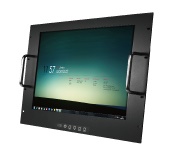Industrial Grade Monitors are used in a wide variety of applications, from indoor displays in buildings and touch screens on factory machinery, to vehicles and outdoor marine applications. There are several different reasons why industrial monitors are used instead of office grade.
Probably the most common two reasons for using industrial grade monitors are the environment, and the shape/size requirements. If a monitor is needed for a harsh environment then it’s obvious that an office grade unit will not be suitable. Also if the application demands that a particular shape and size of monitor is required, and this can’t be found in the office/consumer LCD products then people often
have to resort to an industrial grade unit.
However if you dig a little deeper, there are many other great features of industrial grade LCD monitors that set them apart from office or consumer grade LCD monitors. Some of these differences are not well known.
Industrial Grade Monitors:
- Are built for harsh industrial and commercial environments, rather than for desktop use in a clean office
- Are designed for 24×7 operation, rather than just 8 hours a day during the week
- Use high quality industrial grade components for long term reliability, rather than lowest cost components
- Have long term availability – most models stick around for many years – critical if you’re incorporating it into your own system
- Use metal housings (powder coated steel, aluminium or stainless steel), rather than plastic
- Offer a choice of power inputs (12VDC, wide range DC, or mains), rather than mains only
- Are available in 4:3 or 16:9 aspect ratios, rather than just 16:9
- Offer a choice of signal inputs (VGA/DVI/HDMI/composite video/etc), rather than a fixed set of inputs
- Offer a choice of touch screen types or glass front
- Are available in many different chassis styles – panel mount, enclosed chassis, open frame, rack mount, etc
- Are available with IP ratings (water and dust proofing)
- Can be internally reinforced for high vibration or marine environments
- Are available with high brightness and wide dimming range, for operation in sunlight and/or darkened rooms
The above features mean that industrial grade LCD’s can carry a significantly higher price tag than regular office grade LCD’s. However in most of the applications where these features are required, the extra cost is not significant compared to the benefits of using an industrial grade monitor.

